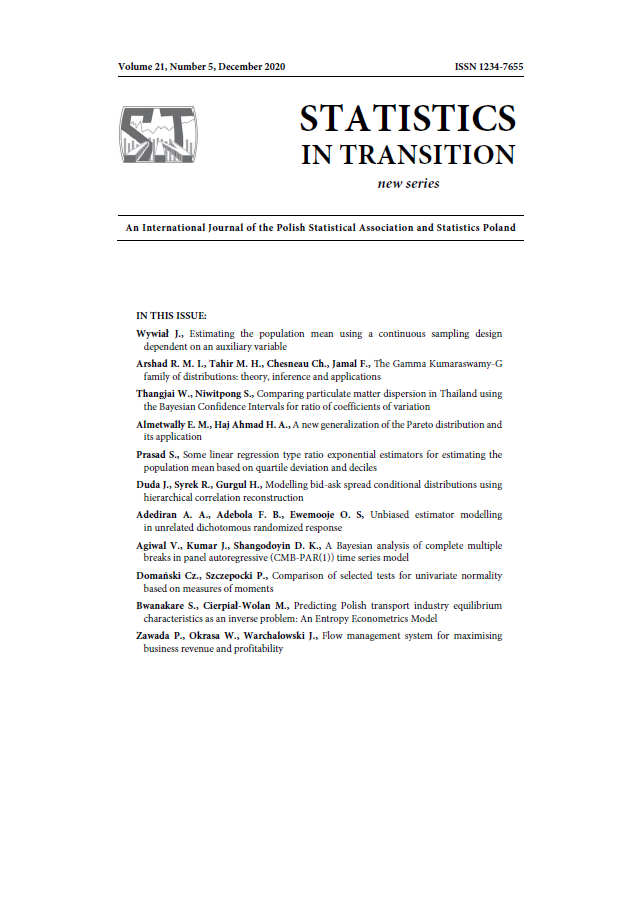ARTICLE
ABSTRACT
Univariate normality tests are typically classified into tests based on empirical distribution, moments, regression and correlation, and other. In this paper, power comparisons of nine normality tests based on measures of moments via the Monte Carlo simulations is extensively examined. The effects on power of the sample size, significance level, and on a number of alternative distributions are investigated. None of the considered tests proved uniformly most powerful for all types of alternative distributions. However, the most powerful tests for different shape departures from normality (symmetric short-tailed, symmetric long-tailed or asymmetric) are indicated.
KEYWORDS
normality tests, Monte Carlo simulation, power of test
REFERENCES
BONETT, D., SEIER, E., (2002). A test of normality with high uniform power. Computational Statistics & Data Analysis, 40(3), pp. 435–445.
BONTEMPS, C., MEDDAHI, N., (2005). Testing Normality: A GMM Approach. Journal of Econometrics, 124(1), pp. 149–186. doi:10.1016/j.jeconom.2004.02.014.
BOWMAN, K. O., SHENTON, L. R., (1975). Omnibus test contours for departures from normality based on b1 and b2. Biometrika, 62(2), pp. 243–250.
BRYS, G., HUBERT, M. and STRUYF, A., (2006). Robust measures of tail weight. Computational Statistics & Data Analysis, 50(3), pp. 733–759. doi:10.1016/j.csda.2004.09.012.
BRYS, G., HUBERT, M. and STRUYF, A., (2004). A Robust Measure of Skewness. Journal of Computational and Graphical Statistics, 13(4), pp. 996–1017. doi:10.1198/106186004x12632.
BRYS, G., HUBERT, M. and STRUYF, A., (2007). Goodness-of-fit tests based on a robust measure of skewness. Computational Statistics, 23(3), pp. 429–442. doi:10.1007/s00180-007-0083-7.
D’AGOSTINO, R. B., PEARSON, E. S., (1973). Tests for Departure From Normality. Empirical Results for the Distributions of b2 and p b1. Biometrika, 60, pp. 613–622. doi:10.1093/biomet/60. 3.613.
D’AGOSTINO, R., BELANGER, A. and D’AGOSTINO, R. JR., (1990). A Suggestion for Using Powerful and Informative Tests of Normality. The American Statistician, 44(4), p. 316. doi:10.2307/2684359.
DOMAN´ SKI, C. K., (2010). Uwagi o testach Jarque-Bera, Przegla˛d Statystyczny, 57(4), pp. 19–26.
DOMAN´ SKI, C. K., JE˛DRZEJCZAK, A., (2017). Consistency Tests Based on Moments. Annales Universitatis Mariae Curie-Skłodowska, sectio H, Oeconomia, 50(4), pp. 89–99. doi:dx.doi.org/10.17951/h.2016.50.4.89.
DOORNIK, J. A., HANSEN, H., (2008). An Omnibus Test for Univariate and Multivariate Normality. Oxford Bulletin of Economics and Statistics, 70, pp. 927–939. doi:10.1111/j.1468-0084. 2008.00537.x.
FARRELL, P. J., ROGERS-STEWART, K., (2006). Comprehensive study of tests for normality and symmetry: extending the Spiegelhalter test. Journal of Statistical Computation and Simulation, 76(9), pp. 803–816. doi:10.1080/10629360500109023.
FISHER, R. A., (1930), The moments of the distribution for normal samples of measures of departure from normality, Proceedings of the Royal Statistical Society A, 130, pp. 16–28.
GEARY, R., (1936). Moments of the Ratio of the Mean Deviation to the Standard Deviation for Normal Samples. Biometrika, 28(3/4), p. 295. doi:10.2307/2333953.
GEL, Y. R., GASTWIRTH, J. L., (2008). A Robust Modification of the Jarque-Bera Test of Normality. Economics Letters, 99(1), pp. 30–32. doi:10.1016/j.econlet.2007.05.022.
HOSKING, J. R. M., (1990). L-Moments: Analysis and Estimation of Distributions Using Linear Combinations of Order Statistics. Journal of the Royal Statistical Society: Series B (Methodological), 52(1), pp. 105–124.
JARQUE, C. M., BERA, A. K., (1987). A Test for Normality of Observations and Regression Residuals. International Statistical Review. Revue International de Statistique, 55(2), pp. 163–172. doi:10.2307/1403192.
JOHNSON, N. L., (1949). Bivariate Distributions Based on Simple Translation Systems . Biometrika. 36 (3/4), pp. 297–304. doi:10.1093/biomet/36.3-4.297.
KOMUNJER, I., (2007). Asymmetric power distribution: Theory and applications to risk measurement. Journal of Applied Econometrics, 22(5), pp. 891–921. doi:10.1002/jae.961.
PIONTEK, K., (2007). Pomiar i testowanie sko´sno´sci rozkładów stóp zwrotu instrumentów finansowych. Prace Naukowe Akademii Ekonomicznej we Wrocławiu. Taksonomia, 14, pp. 122–130.(in Polish).
ROMAO, X., DELGADO, R. and COSTA, A., (2010). An empirical power comparison of univariate goodness-of-fit tests for normality. Journal of Statistical Computation and Simulation, 80(5), pp. 545–591. doi:10.1080/00949650902740824.
THADEWALD, T., BÜNING, H., (2007). Jarque–Bera Test and its Competitors for Testing Normality – A Power Comparison. Journal of Applied Statistics, 34(1, pp. 87–105. doi:10.1080/02664760600994539.
STEIN, C., (1972). A bound for the error in the normal approximation to the distribution of a sum of dependant random variables. Proceedings of the Sixth Berkeley Symposium on Mathematics, Statistics and Probability, Vol. 2, pp. 583–602.251.doi:10.1016/S0165-1765(96)00923-8.
WIJEKULARATHNA, D. K., MANAGE, A. B. W. and SCARIANO, S. M. (2019). Power analysis of several normality tests: A Monte Carlo simulation study. Communications in Statistics - Simulation and Computation, pp. 1–17. doi:10.1080/03610918.2019.1658780.
WILSON E. B., HILFERTY M. M., (1931). The Distribution of Chi-square. Proceedings of the National Academy of Sciences of the United States of America Vol. 17, No. 12, pp. 684–688. doi:10.1073/pnas.17.12.684.
YAP, B. W., SIM, C. H., (2011). Comparisons of various types of normality tests. Journal of Statistical Computation and Simulation, 81(12), pp. 2141–2155.
ZGHOUL, A. A., (2010). A Goodness of Fit Test for Normality Based on the Empirical Moment Generating Function. Communications in Statistics – Simulation and Computation, 39(6), pp. 1292–1304.
